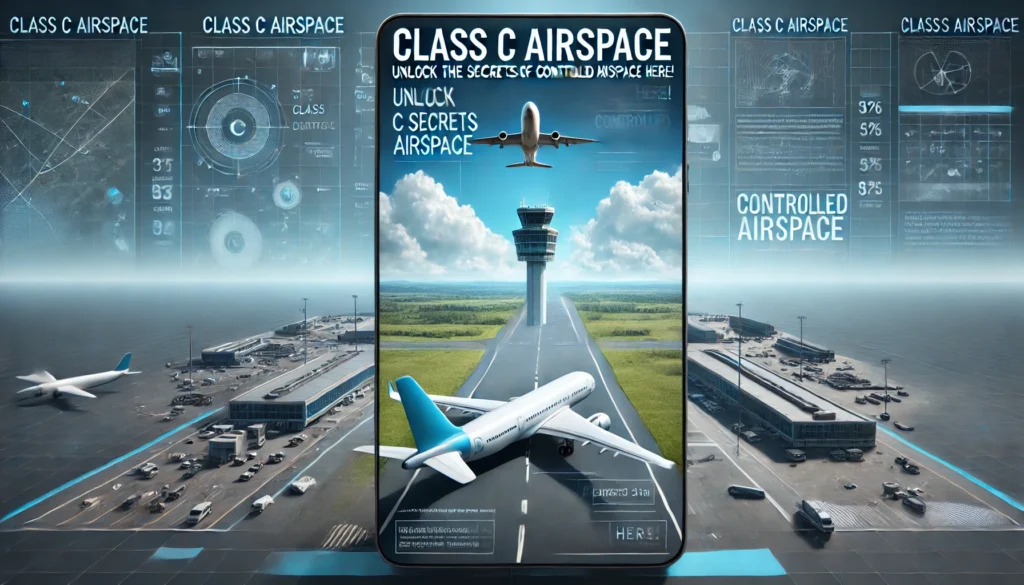Welcome to “Wings Over Cloud,” your go-to resource for all things aviation. Today, we’re diving deep into the intricacies of Class C airspace. Whether you’re a seasoned pilot, a student aviator, or simply an aviation enthusiast, this guide will provide comprehensive insights into Class C airspace, covering its dimensions, requirements, rules, and much more.
What is Class C Airspace?

Class C airspace is a type of controlled airspace that surrounds busy airports. It is designed to manage the flow of traffic and enhance safety. This airspace is crucial for pilots to understand due to its specific regulations and the necessity of communication with air traffic control (ATC).
Key Characteristics of Class C Airspace
- Controlled Airspace: Class C is controlled, meaning ATC provides services and manages the airspace.
- Two-Layer Structure: It typically has two distinct layers—a core surface area and a shelf area above it.
- ATC Communication: Mandatory two-way communication with ATC is required before entering Class C airspace.
Dimensions of Class C Airspace
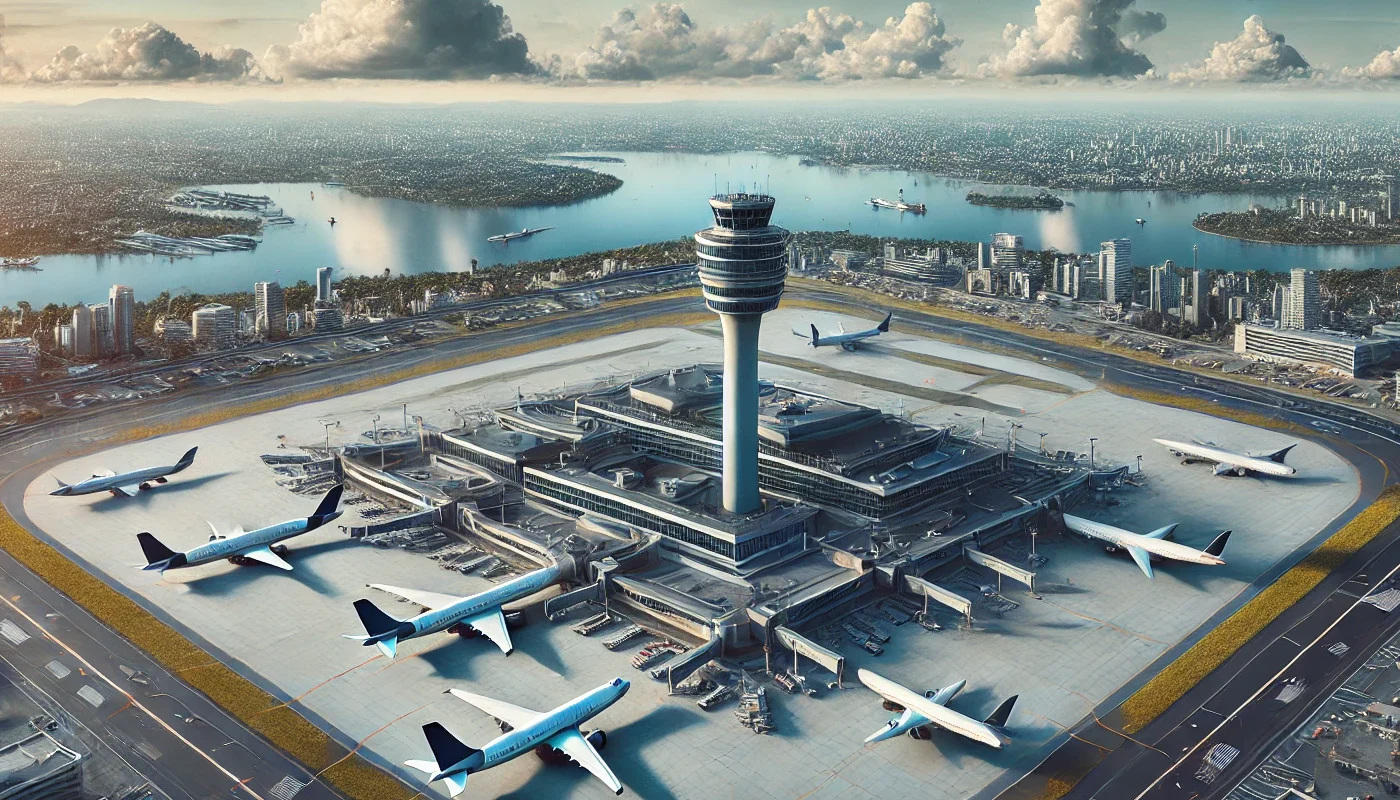
Class C Airspace Dimensions
The dimensions of Class C airspace generally include a surface area with a radius of 5 nautical miles around the primary airport, extending up to 4,000 feet above ground level (AGL). Additionally, there is an outer area with a radius of 10 nautical miles, starting at 1,200 feet AGL and extending up to the same ceiling.
- Core Surface Area: Radius of 5 nautical miles, from the surface up to 4,000 feet AGL.
- Outer Shelf Area: Radius of 10 nautical miles, starting at 1,200 feet AGL up to 4,000 feet AGL.
Class C Airspace Vertical Limit
The vertical limit of Class C airspace is generally up to 4,000 feet AGL. This ensures adequate separation between aircraft operating at different altitudes.
Describe the Typical Dimensions of Class C Airspace
Moreover, Class C airspace typically extends from the surface to 4,000 feet AGL in the core area, with a radius of 5 nautical miles, the outer shelf starts at 1,200 feet AGL and extends to the same vertical limit with a 10-nautical mile radius, As these dimensions help manage a higher volume of air traffic efficiently.
Class C Airspace Requirements
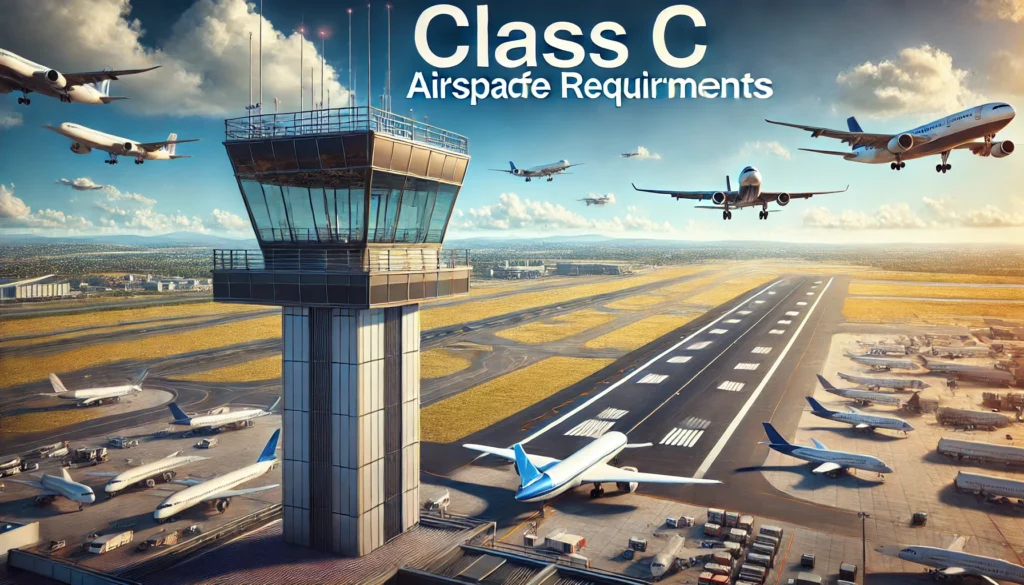
Entry Requirements
To enter Class C airspace, pilots must establish two-way radio communication with ATC. Moreover, This involves contacting ATC and receiving an acknowledgment of the aircraft’s call sign. However, Without this acknowledgment, entry into Class C airspace is prohibited.
- Radio Communication: Required before entry.
- Transponder with Mode C: Aircraft must have an operational transponder with Mode C, which provides altitude reporting.
Equipment Requirements
To operate within Class C airspace, aircraft must be equipped with:
- Two-Way Radio: For continuous communication with ATC.
- Transponder with Mode C: For altitude reporting.
- ADS-B Out Equipment: Required in most cases, but there are specific exceptions.
Minimum Radio Equipment for Class C Airspace
Moreover, The minimum radio equipment required for Class C airspace includes a two-way radio for communication with ATC and a transponder with Mode C for altitude reporting. Thus, These ensure that the aircraft can be tracked and communicated with effectively.
Can Aircraft Without ADS-B Out Equipment Overfly Class C Airspace?
Aircraft without ADS-B Out equipment can overfly Class C airspace under certain conditions. However, pilots must ensure they comply with specific regulations and maintain communication with ATC to avoid any conflicts.
Class C Airspace Rules

Speed Limits
The speed limit in Class C airspace is 200 knots (230 mph) when at or below 2,500 feet AGL within 4 nautical miles of the primary airport, this helps manage traffic and ensures safety.
Operations and Communications
All operations within Class C airspace must be coordinated with ATC. Pilots must adhere to ATC instructions and maintain continuous communication. Thus, This ensures orderly flow and separation of air traffic.
Class C Airspace Speed Limit
The speed limit in Class C airspace is strictly enforced to ensure safety. Furthermore, At or below 2,500 feet AGL, within 4 nautical miles of the primary airport, aircraft must not exceed 200 knots, as this regulation helps manage traffic density and maintain safe separation between aircraft.
Can You Fly a Drone in Class C Airspace?
Flying a drone in Class C airspace is permitted, but it requires prior authorization from ATC. Drone operators must comply with specific regulations and coordinate with ATC to ensure safe operations.
All Operations Within Class C Airspace Must Be Coordinated with ATC
All operations within Class C airspace must be per ATC instructions. This includes both manned and unmanned aircraft. Maintaining continuous communication with ATC is essential for the safe and efficient flow of air traffic.
Comparing Class B vs Class C Airspace
Class B airspace surrounds the nation’s busiest airports and has more stringent requirements compared to Class C airspace. Class B requires a clearance to enter, while Class C only requires two-way communication. Additionally, Class B has higher altitude limits and stricter equipment requirements.
Class C vs Class D Airspace
Moreover, Class C airspace differs from Class D airspace primarily in its structure and requirements. However, Class D airspace typically extends from the surface to 2,500 feet AGL and requires only two-way communication with ATC without the altitude reporting equipment needed for Class C airspace.
Class E Airspace: Decode the Secrets of the Sky Now!
Entering Class C Airspace
How to Enter Class C Airspace
To enter Class C airspace, follow these steps:
- Initial Contact: Establish two-way radio communication with ATC.
- Receive Acknowledgment: Ensure ATC acknowledges your call sign.
- Follow ATC Instructions: Adhere to instructions provided by ATC for entry and operations within Class C airspace.
Clearance and Communications
While explicit clearance is not required, two-way communication must be established and maintained. Pilots should be familiar with the airspace’s structure and adhere to ATC instructions at all times.
What is Required to Enter Class C Airspace?
To enter Class C airspace, you need a functioning two-way radio and a transponder with Mode C. Additionally, establishing communication with ATC and receiving an acknowledgment of your call sign is mandatory before entering.
Do You Need Clearance to Enter Class C Airspace?
No explicit clearance is needed to enter Class C airspace, but two-way communication with ATC must be established. ATC must acknowledge your call sign before you can legally enter the airspace.
Can You Fly Over Class C Airspace?
Yes, you can fly over Class C airspace if you maintain an altitude above its vertical limit. Pilots should ensure compliance with any other applicable regulations and coordinate with ATC if necessary.
Can You Fly Under Class C Airspace Without ADS-B?
Yes, you can fly under Class C airspace without ADS-B Out equipment as long as you remain below the lower limits of the shelf area. However, maintaining communication with ATC and complying with other relevant regulations is still essential.
Navigating Class C Airspace
On Sectional Charts
Class C airspace is depicted on sectional charts with a solid magenta line. Thus, The core and shelf areas are marked, showing the radii and altitude limits and Pilots should familiarize themselves with these charts to navigate accurately.
Altitudes and Transitions
When transitioning through Class C airspace, maintain awareness of altitude restrictions. Vertical & horizontal transitions should be coordinated with ATC to ensure safety and compliance with regulations.
Class C Airspace Transition Procedures
Moreover, Transitioning through Class C airspace involves maintaining communication with ATC and adhering to altitude restrictions and Pilots should ensure they follow ATC instructions and comply with all applicable regulations to navigate safely.
Class C Airspace on Sectional Charts
Class C airspace is represented on sectional charts with solid magenta lines. Thus, The charts show the core and outer areas, including the respective altitudes and radii, helping pilots navigate the airspace efficiently.
Class C Airspace Depictions
Class C airspace is depicted on sectional charts with a solid magenta line. The core and shelf areas are marked, showing the radii and altitude limits. Pilots should familiarize themselves with these charts to navigate accurately.
Outer Area of Class C Airspace
The outer area of Class C airspace extends to a radius of 10 nautical miles from the primary airport. However, It starts at 1,200 feet AGL and extends up to 4,000 feet AGL, facilitating the management of arriving and departing aircraft.
Class C Airspace Ceiling
The ceiling of Class C airspace typically extends up to 4,000 feet AGL. This vertical limit helps manage the air traffic efficiently, separating it from the higher altitude aircraft operating in other classes of airspace.
The Vertical Limit of Class C Airspace is Generally Up to 4,000 Feet AGL
The vertical limit of Class C airspace is generally up to 4,000 feet AGL. Moreover, This allows for adequate separation between aircraft operating in different layers of the airspace, enhancing safety and efficiency.
Airspeed in Class C Airspace
When operating in Class C airspace, maintaining a controlled airspeed is crucial. The maximum airspeed is restricted to 200 knots when flying at or below 2,500 feet AGL within 4 nautical miles of the primary airport.
FAA Class C Airspace
However, The FAA regulates Class C airspace to enhance safety and manage air traffic around busy airports, So Understanding these regulations helps pilots and drone operators comply with requirements and ensure safe operations.
Class C Airspace Transition
When transitioning through Class C airspace, maintaining awareness of altitude restrictions is crucial. Vertical and horizontal transitions should be coordinated with ATC to ensure safety and compliance with regulations.
Max Airspeed in Class C Airspace
The maximum airspeed in Class C airspace is 200 knots. This restriction helps manage traffic and maintain safe separation between aircraft, ensuring efficient operations.
Airplane Speed Limits in Class C Airspace
Airplane speed limits in Class C airspace are enforced to ensure safety. At or below 2,500 feet AGL, within 4 nautical miles of the primary airport, aircraft must not exceed 200 knots.
Class C Airspace Altitudes
Class C Airspace Altitude
Moreover, Class C airspace typically extends from the surface to 4,000 feet AGL and this vertical limit helps manage the air traffic efficiently, separating it from the higher altitude aircraft operating in other classes of airspace.
Class C Airspace Heights
The height of Class C airspace is generally up to 4,000 feet AGL. This allows for adequate separation between aircraft operating in different layers of the airspace, enhancing safety and efficiency.
Class C Airspace Height Limits
Class C airspace height limits are defined to manage air traffic effectively. The core area extends from the surface to 4,000 feet AGL, while the outer shelf starts at 1,200 feet AGL and extends to the same ceiling.
Special Considerations for Drones in Class C Airspace
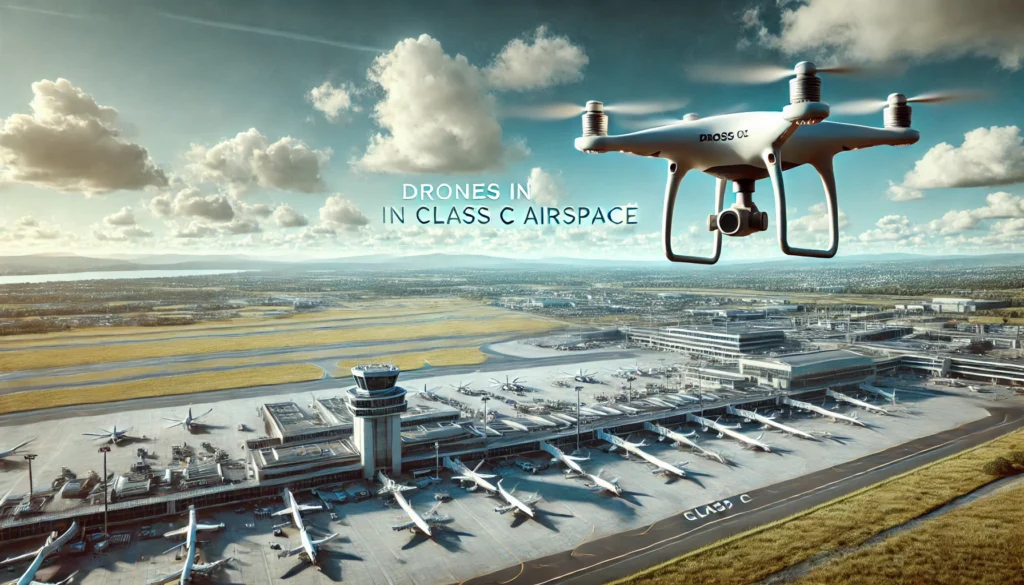
Drone Rules and Regulations in Class C Airspace
Drone operations in Class C airspace require authorization from ATC. Operators must comply with Part 107 regulations, which include maintaining a visual line of sight, flying below 400 feet AGL, and avoiding manned aircraft.
Class C Airspace Drone Rules
Operating a drone in Class C airspace involves specific rules and regulations. Authorization from ATC is mandatory, and operators must ensure compliance with all applicable regulations to avoid conflicts with manned aircraft.
Flying a Drone in Class C Airspace
Flying a drone in Class C airspace requires prior authorization from ATC. Thus, Operators must adhere to all relevant regulations, maintain a visual line of sight, and ensure safe separation from manned aircraft.
Can You Fly a Drone in Class C Airspace?
Flying a drone in Class C airspace is permitted, but it requires prior authorization from ATC. Drone operators must comply with specific regulations and coordinate with ATC to ensure safe operations.
Drones in Class C Airspace
Drones can operate in Class C airspace with prior ATC authorization. Operators must follow Part 107 regulations, maintain a visual line of sight, and avoid manned aircraft to ensure safe operations.
Flying Drone in Class C Airspace
Moreover, To fly a drone in Class C airspace, operators must obtain authorization from ATC and adhere to all Part 107 regulations, this includes maintaining a visual line of sight and ensuring safe separation from manned aircraft.
Class C Airspace Clearance
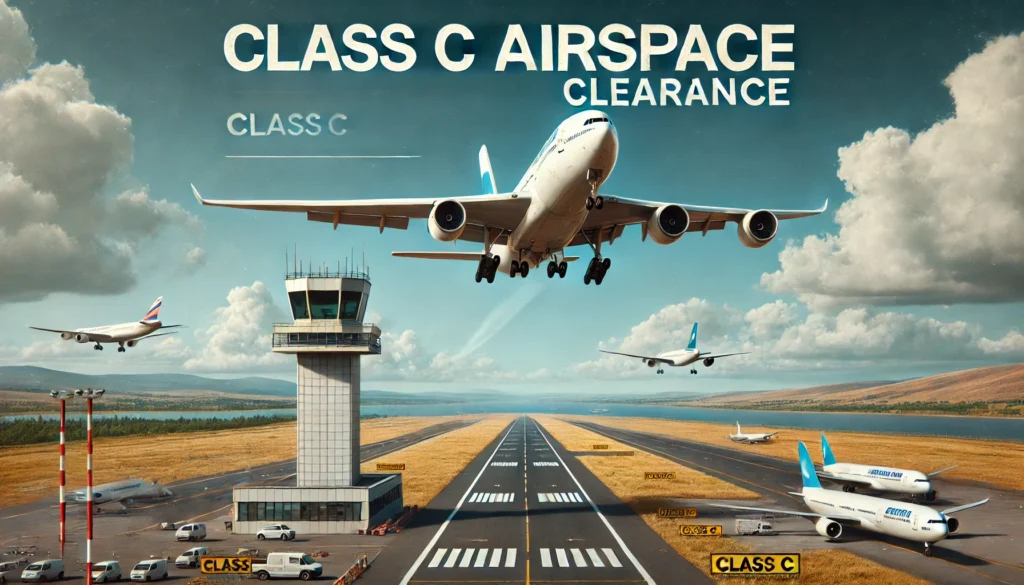
Do You Need Clearance to Enter Class C Airspace?
No explicit clearance is needed to enter Class C airspace. But ATC must acknowledge your call sign before you can legally enter the airspace.
Class C Airspace Entry Requirements
To enter Class C airspace, you need a functioning two-way radio and a transponder with Mode C. Additionally, establishing communication with ATC and receiving an acknowledgment of your call sign is mandatory before entering.
Requirements to Enter Class C Airspace
Entering Class C airspace requires specific equipment and communication protocols. Pilots must have a functioning two-way radio, and a transponder with Mode C, and must establish communication with ATC, receiving acknowledgment of their call sign before entry.
What Do You Need to Enter Class C Airspace?
To enter Class C airspace, you need a two-way radio for communication with ATC and a transponder with Mode C for altitude reporting. Establishing communication with ATC & receiving acknowledgment of your call sign is also required.
Controlled Airspace C Class
Class C airspace is a type of controlled airspace that surrounds busy airports. It is designed to manage the flow of traffic and enhance safety. This airspace is crucial for pilots to understand due to its specific regulations and the necessity of communication with air traffic control (ATC).
Wrap-Up
Class C airspace plays a vital role in managing air traffic around busy airports. Understanding its dimensions, requirements, and rules is essential for safe and efficient operations. Whether you’re piloting an aircraft or flying a drone, adherence to ATC instructions and compliance with regulations is paramount. Moreover, Stay informed, communicate effectively, and enjoy your flight experiences within Class C airspace. Besides this, Click here if you want to learn about Class E Airspace or Click Here if you want to learn about Vertical Speed Indicators
Furthermore, For more detailed articles on aviation topics, visit our website “Wings Over Cloud” Moreover, also do check out our latest product range. Keep flying high & Stay Safe!

